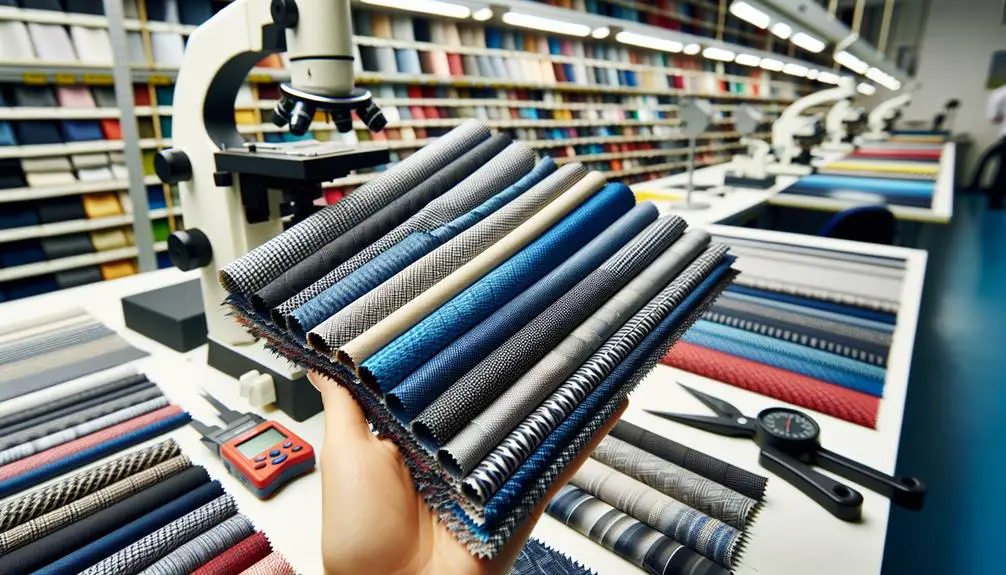When you think about selecting the right fabric for a specific use, understanding tensile strength is essential. Knowing how a fabric can handle tension without tearing or breaking can greatly impact its performance and longevity. You'll find that yarn quality, weave patterns, and fiber type all contribute to this important characteristic. But how exactly can you measure tensile strength and guarantee the fabric meets industry standards? There are various methods and testing standards to take into account, each with its own set of advantages and limitations, waiting to be explored.
Table of Contents
Key Takeaways
- Tensile strength measures a fabric's ability to withstand tension without breaking, crucial for longevity and safety.
- Yarn quality, weave patterns, and fiber type significantly influence a fabric's tensile strength.
- Common testing methods include Grab Test, Strip Test, and Tear Resistance Test, adhering to standards like ASTM and ISO.
- High tensile strength is vital in industries like automotive, construction, healthcare, and textiles for safety and performance.
- Visual inspection and specialized equipment are essential for accurate evaluation of fabric tensile strength.
Definition of Tensile Strength
Tensile strength measures a fabric's ability to withstand tension without breaking. When you're delving into the world of textiles, understanding tensile strength is crucial for mastering fabric durability. This property isn't just about how much force a fabric can endure; it's a demonstration of the quality and longevity of the material.
During material testing, fabrics undergo rigorous assessments where they're stretched to their limits. These tests reveal how fabrics respond under stress, helping you determine whether a material will hold up under the demands of its intended use.
For example, in high-performance applications like outdoor gear or industrial textiles, a high tensile strength is essential.
Importance in Fabric Selection
When choosing fabrics for any project, understanding their tensile strength helps guarantee you pick materials that will meet the demands of their intended use. Recognizing fabric strength is essential for securing fabric durability and performance, whether you're working on clothing, upholstery, or industrial applications. By focusing on tensile strength during fabric selection, you can avoid costly errors and secure your project stands the test of time.
Here are some key reasons why tensile strength should be a priority in fabric selection:
- Longevity: High tensile strength means the fabric can withstand wear and tear, prolonging the lifespan of your product.
- Safety: For applications like industrial workwear or sports gear, strong fabrics reduce the risk of tears and injuries.
- Maintenance: Durable fabrics require fewer repairs and replacements, saving time and resources in the long run.
- Functional Performance: For items like tents or sails, fabric strength directly impacts their ability to perform under stress.
- Aesthetic Value: Strong fabrics maintain their appearance longer, resisting damage that can detract from their visual appeal.
Mastering fabric selection based on tensile strength ensures that your projects not only look good but also perform well under various conditions.
Factors Affecting Tensile Strength
Several key factors influence the tensile strength of fabrics, determining their durability and suitability for different applications.
First, yarn quality plays a pivotal role. High-quality yarns, made from long, strong fibers, greatly enhance tensile strength. You'll find that the consistency and uniformity of the yarn also matter; irregularities can create weak points that compromise the fabric's integrity.
Next, consider the weave pattern. Different patterns distribute stress differently across the fabric. For instance, plain weaves provide uniform strength but may lack flexibility. Twill weaves, on the other hand, offer both strength and flexibility due to their diagonal structure. Understanding these patterns allows you to select the right fabric for specific uses, balancing strength and other desired properties.
Fiber type is another vital factor. Natural fibers like cotton and wool have inherent strengths and weaknesses, while synthetic fibers such as polyester and nylon are engineered for higher tensile strength. The choice of fiber impacts not only the tensile strength but also other attributes like elasticity and abrasion resistance.
Methods of Measurement
To understand tensile strength in fabrics, you'll explore various tensile testing techniques. These methods allow you to assess how different materials perform under stress.
Comparing measurement standards guarantees accurate and consistent results across different tests.
Tensile Testing Techniques
Understanding tensile testing techniques is essential for accurately measuring a fabric's strength and durability. When you're evaluating the breaking strength or analyzing fabric stretching, you'll need precise methods to get reliable data.
Here are some key techniques you should master for thorough tensile testing:
- Grab Test: This method measures the breaking strength by gripping the fabric at both ends and applying force until it breaks.
- Strip Test: Similar to the grab test, but the entire width of the fabric strip is gripped, providing a broader analysis.
- Multi-Axial Test: Evaluates fabric's strength in multiple directions simultaneously, useful for materials subjected to complex forces.
- Cyclic Load Test: Repeatedly stretches and relaxes the fabric to simulate real-world wear and assess durability over time.
- Tear Resistance Test: Measures the force needed to propagate a tear, giving insights into the fabric's robustness.
Measurement Standards Comparison
Comparing different measurement standards, you'll find that each method offers unique insights into the tensile properties of fabrics. International standards like ASTM (American Society for Testing and Materials) and ISO (International Organization for Standardization) are the gold standard for ensuring testing accuracy. They define specific protocols for tensile measurement, helping you achieve consistent and reliable results.
When you adhere to these standards, you're not just following a set of rules. You're ensuring that the tensile strength data you obtain is both reproducible and comparable across different studies and applications. This is pivotal for maintaining fabric quality, especially when you're dealing with high-performance textiles.
By following ASTM standards, you'll measure tensile properties under controlled conditions, using standardized equipment and procedures. ISO standards, on the other hand, might offer different testing environments but aim for the same level of precision and reliability. Understanding these nuances helps you select the most appropriate method for your specific needs.
Ultimately, mastering these measurement standards empowers you to make informed decisions about fabric quality. You'll be able to identify which textiles meet your performance requirements and which ones fall short, ensuring your projects always succeed.
Common Testing Standards
When evaluating tensile strength in fabrics, you'll often encounter several key testing standards that guarantee consistency and reliability in results. These standards are developed by international bodies to make certain that tensile strength variations and fabric quality are measured uniformly across different regions and industries. Understanding these testing procedures allows you to accurately gauge the durability and performance of various fabrics.
Here are five common testing standards you should be familiar with:
- ASTM D5034: This standard test method, developed by the American Society for Testing and Materials, evaluates the tensile strength and elongation of textile fabrics.
- ISO 13934-1: The International Organization for Standardization has created this test to measure the tensile properties of fabrics using the strip method.
- ISO 13934-2: Another ISO standard, this one uses the grab method to determine tensile strength, offering a different approach to fabric testing.
- DIN 53857: A German standard that specifies the tensile testing of textiles, providing detailed procedures for accurate results.
- BS 2576: The British Standard for evaluating the tensile properties of woven fabrics, ensuring quality and consistency in fabric performance assessments.
Mastering these standards will enable you to effectively evaluate and compare the tensile strength of various fabrics, guaranteeing top-notch fabric quality for your specific needs.
Applications in Different Industries
How do different industries leverage tensile strength testing to guarantee their fabrics meet specific performance requirements?
In the automotive industry, manufacturers rely on tensile strength testing to secure seat belts and airbags can endure extreme forces during collisions. You'll find that robust fabrics are essential for safety.
Similarly, in the construction sector, high-tensile fabrics are used in geotextiles and safety nets, providing stability and protection on-site. These applications demand materials that can withstand substantial stress without tearing, ensuring both durability and safety.
In the textile industry, tensile strength is crucial for producing high-quality garments and home furnishings. When you examine performance wear, for instance, it's clear that fabric durability is non-negotiable. Textiles must resist wear and tear from rigorous physical activities.
Meanwhile, in the medical field, tensile strength testing ensures that materials used in items like surgical gowns and bandages won't fail under pressure. You need reliable, strong fabrics to maintain sterility and protect patients and healthcare providers.
Tips for Evaluating Fabrics
When evaluating fabrics, start by using visual inspection techniques to identify any obvious defects.
Next, familiarize yourself with essential testing equipment to measure tensile strength accurately.
Visual Inspection Techniques
To evaluate a fabric's tensile strength, start by closely examining its weave and texture. A thorough visual inspection can reveal a lot about fabric quality and durability. It's crucial to use reliable visual inspection techniques to make sure you're working with the best materials.
First, observe the weave pattern. A tight, uniform weave generally indicates a stronger fabric. Look for inconsistencies or loose threads, which can signal weak points. Also, feel the texture; a smooth, even surface often correlates with higher quality.
Pay attention to the fabric's weight and thickness. Heavier fabrics typically have higher tensile strength. Examine the edges for fraying, as this can indicate potential durability issues. Check for any visible defects, such as holes or thin spots, which can compromise the fabric's reliability.
Consider these key points during your inspection:
- Weave Consistency: Uniform patterns indicate strength.
- Texture Quality: Smooth surfaces suggest better quality.
- Weight and Thickness: Heavier fabrics are usually stronger.
- Edge Fraying: Frayed edges can point to durability issues.
- Visible Defects: Holes or thin spots decrease reliability.
Testing Equipment Essentials
Investing in reliable testing equipment is necessary for accurately evaluating a fabric's tensile strength. Begin by selecting high-quality tensile testers, which guarantee precise results.
To maintain their effectiveness, prioritize regular equipment maintenance. This includes timely inspections and replacement of worn-out parts to prevent inaccuracies.
Calibration standards play an important role in ensuring your equipment provides consistent results. Follow industry guidelines to regularly calibrate your machines, and document every calibration session. This practice not only maintains accuracy but also builds a dependable data history.
When testing fabrics, incorporate testing variations to cover a range of conditions. Variations could include different strain rates, environmental settings, and fabric orientations. These variations simulate real-world scenarios, giving you a thorough understanding of the fabric's performance.
Effective data analysis techniques are essential for interpreting results. Utilize software that can handle statistical analysis, trend identification, and comparison of multiple data sets. Being proficient in these techniques allows you to draw meaningful conclusions and make informed decisions.
Comparing Material Durability
Evaluating fabric durability starts with understanding key performance indicators like abrasion resistance, tear strength, and seam slippage. To ensure you're selecting the best material for your needs, focus on these aspects to gauge fabric longevity and resilience.
First, consider abrasion resistance. This measures how well the fabric withstands wear and tear from friction. Higher abrasion resistance means longer-lasting material.
Next, tear strength is essential. This shows how much force the fabric can take before it starts tearing, indicating its resilience under stress.
Seam slippage refers to the fabric's ability to hold stitches without pulling apart, impacting overall durability.
When comparing materials, keep these tips in mind:
- Abrasion resistance: Higher scores indicate better wear and tear performance.
- Tear strength: Look for fabrics with high tear strength for greater resilience.
- Seam slippage: Fabrics that resist seam slippage maintain structural integrity longer.
- Manufacturer testing: Check if the fabric has undergone rigorous testing for these indicators.
- User reviews: Real-world feedback can offer insights into fabric longevity and durability.
Frequently Asked Questions
How Does Tensile Strength Differ From Fabric Durability?
You might think tensile strength and durability are the same, but they're not. Tensile strength vs durability involves fabric strength enhancement. Misconceptions about tensile strength arise from weave impact. Eco-friendly options can also affect both.
Can Tensile Strength Be Improved After Fabric Production?
Yes, you can improve tensile strength after fabric production. Use post-production treatments and reinforcement techniques. Applying chemical additives and conducting thorough fabric testing will help in enhancing the fabric's durability and overall tensile strength.
What Are Common Misconceptions About Tensile Strength in Fabrics?
You often encounter tensile strength misconceptions. A common myth is that thicker fabric always means stronger fabric. Important considerations include fiber type, weave, and treatment. Fabric strength factors are more nuanced than you might think.
How Does Fabric Weave Affect Tensile Strength?
You need to understand that fabric weave directly impacts tensile strength. Yarn selection and fabric stability play essential roles. Through tensile testing, you'll see how different weaves influence fabric performance, affecting durability and overall strength.
Are There Eco-Friendly Fabrics With High Tensile Strength?
When you explore sustainable options, you'll find high-performance, eco-friendly fabrics like hemp and Tencel. These strong fibers don't just do the trick; they offer impressive tensile strength while being kind to the environment.
- How Does Ring Spun Cotton Affect Garment Fit and Shape Retention? - August 13, 2024
- What Are the Challenges in Producing Ring Spun Cotton? - August 13, 2024
- Is Ring Spun Cotton Suitable for Plus-Size Clothing? - August 13, 2024





